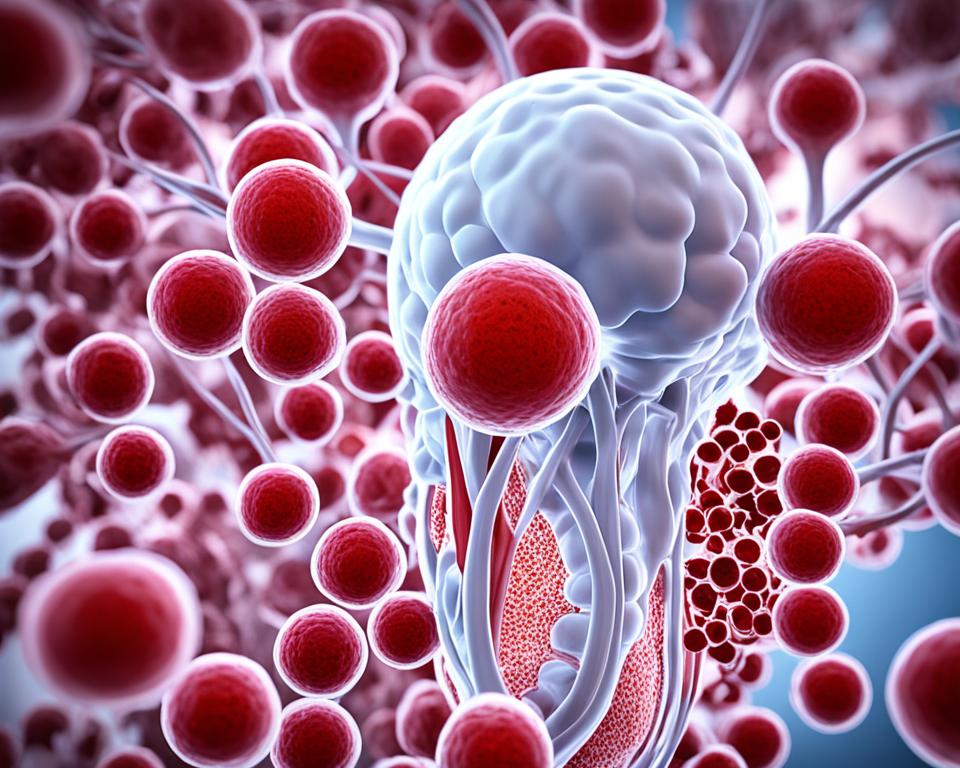Uterine fibroids and anemia are common health issues that often affect women together. They can greatly impact a woman’s health, causing physical and emotional problems. This article will look into how fibroids and anemia are linked, covering their causes, symptoms, and treatment options.
Uterine fibroids are non-cancerous growths in the uterus, found in up to 80% of women by age 50. Anemia, a lack of red blood cells or hemoglobin, can result from the heavy bleeding caused by fibroids. This link between fibroids and anemia can make things worse, leading to poor health and a lower quality of life.
Read interesting things at : trainwithnexus
Key Takeaways
- Fibroids and anemia are closely linked, with heavy menstrual bleeding from fibroids often leading to iron deficiency and anemia.
- Factors such as age, hormonal imbalances, and genetics can increase the risk of developing fibroids and anemia.
- Symptoms of fibroids and anemia can include heavy menstrual bleeding, pelvic pain, abdominal discomfort, fatigue, dizziness, and shortness of breath.
- Diagnosis involves a combination of physical examinations, imaging tests, and blood tests to assess the presence and severity of fibroids and anemia.
- Treatment options for fibroids and anemia range from medications and iron supplements to surgical interventions, depending on the individual’s condition and preferences.
What are Fibroids and Anemia?
Uterine fibroids are growths that are not cancerous and happen inside the uterus. They can be small or big and cause symptoms like heavy bleeding, pain, and discomfort in the belly.
Understanding Uterine Fibroids
Uterine fibroids, also known as leiomyomas, are common in women. They can be tiny or huge, changing the uterus’s shape and size. The exact reason they form is still a mystery, but hormones and genes might have something to do with it.
Exploring Anemia and Its Types
Anemia means not having enough red blood cells or they’re not working right. These cells carry oxygen around the body. Iron deficiency anemia is the most common type. People with anemia might feel tired, dizzy, or breathe short.
Other anemias include vitamin deficiency, hemolytic, and aplastic anemia. Each has its own cause and effects.
| Type of Anemia | Characteristics |
|---|---|
| Iron Deficiency Anemia | Caused by a lack of iron in the body, leading to a decrease in the production of hemoglobin, the oxygen-carrying component of red blood cells. |
| Vitamin Deficiency Anemia | Caused by a lack of vitamins, such as vitamin B12 or folate, which are necessary for the production of healthy red blood cells. |
| Hemolytic Anemia | Caused by the premature destruction of red blood cells, leading to a decrease in the number of functional red blood cells. |
| Aplastic Anemia | Caused by the failure of the bone marrow to produce enough new red blood cells, leading to a decrease in the overall number of red blood cells. |
Fibroids and Anemia: The Link
Uterine fibroids and anemia are closely linked. Heavy menstrual bleeding from fibroids can lead to anemia. This creates a cycle that affects health and quality of life.
Fibroids cause heavy bleeding by making the uterine lining thicken. This leads to losing iron, which is vital for making red blood cells. Without enough iron, anemia sets in.
The symptoms of fibroids and anemia often overlap. Signs like heavy bleeding, pelvic pain, and stomach discomfort can point to both issues. This makes it hard to tell which condition is causing the symptoms, leading to poor health.
“The presence of fibroids can exacerbate the symptoms of anemia, creating a cyclical pattern that can significantly impact an individual’s overall health and quality of life.”
Knowing how fibroids and anemia are connected helps in finding the right treatments. By tackling both conditions, doctors can help patients feel better and improve their lives.
Risk Factors for Developing Fibroids and Anemia
Age and hormonal changes can raise the risk of getting both uterine fibroids and anemia. Women in their reproductive years often face a higher chance of getting fibroids. These growths are triggered by hormonal shifts throughout a woman’s life. Hormonal changes can also affect iron levels, leading to anemia.
Age and Hormonal Factors
Women’s risk of getting fibroids and anemia goes up as they get older. The reproductive years bring changes in estrogen and progesterone levels. These changes can make fibroids grow. Hormonal imbalances can also mess with iron levels, making anemia more likely.
Genetics and Family History
Genetics and family history are big factors in getting fibroids and anemia. If a family member has had these conditions, you might be more likely to get them too. This points to genetic or family-specific traits that increase health risks.
| Risk Factor | Fibroids | Anemia |
|---|---|---|
| Age | Increased risk during reproductive years | Increased risk with advancing age |
| Hormonal Imbalances | Stimulate fibroid growth | Disrupt iron metabolism |
| Genetics and Family History | Increased risk with close relatives | Increased risk with close relatives |
“Understanding the risk factors for both fibroids and anemia is crucial in developing effective prevention and management strategies.”
Symptoms of Fibroids and Anemia
Women with uterine fibroids and anemia often face a tough cycle. One key symptom is heavy menstrual bleeding. This bleeding can lead to losing a lot of iron, causing anemia. This cycle can make both conditions worse, hurting a woman’s health.
Heavy Menstrual Bleeding
Women with fibroids may see heavy menstrual bleeding, or menorrhagia. This can mean losing a lot of iron, leading to anemia. The two conditions can feed into each other, making managing the bleeding harder.
Pelvic Pain and Abdominal Discomfort
Fibroids can also cause pelvic pain and abdominal discomfort. These issues can happen alone or with heavy bleeding. Fibroids can press on nearby organs and nerves, causing discomfort. This can affect a woman’s life and health.
“The combination of fibroids and anemia can create a vicious cycle, where the heavy bleeding exacerbates the anemia, and the anemia, in turn, makes the bleeding more difficult to manage.”
Women should know how fibroids and anemia are linked. Spotting these symptoms early can help manage them better and improve health.
Diagnosing Fibroids and Anemia
Understanding and managing health conditions like uterine fibroids and anemia starts with accurate diagnosis. Doctors use physical exams and imaging tests to check for fibroids. Blood tests help figure out the type and severity of anemia.
Physical Examination and Imaging Tests
A healthcare provider will do a pelvic exam during a physical check-up. This helps feel for any unusual growths in the uterus. Imaging tests like ultrasound, MRI, and hysteroscopy are often used next.
- Transvaginal or abdominal ultrasound: This test shows the uterus and spots fibroids, their size, and how many there are.
- Magnetic Resonance Imaging (MRI): MRI scans give a detailed look at the uterus and fibroids, helping doctors understand their nature.
- Hysteroscopy: This procedure uses a small camera to look inside the uterus, spotting any issues, including fibroids.
Blood Tests for Anemia
To spot anemia, doctors order blood tests like a complete blood count (CBC) and an iron panel. These tests show the type and how bad anemia is, and what might be causing it, like iron deficiency. The CBC checks red blood cell levels and other important parts. The iron panel looks at iron levels and related markers.
| Blood Test | Purpose |
|---|---|
| Complete Blood Count (CBC) | Measures red blood cell count, hemoglobin, and other key components to determine the presence and type of anemia. |
| Iron Panel | Assesses the body’s iron stores and related markers to identify the cause of anemia, such as iron deficiency. |
By using physical exams, imaging tests, and blood tests, doctors can accurately diagnose fibroids and anemia. This helps plan the best treatment and care.
Treatment Options for Fibroids and Anemia
Managing fibroids and anemia often means using a mix of treatments. This approach helps meet the unique needs of each person. Doctors might suggest a blend of medicines, iron supplements, and surgery to ease symptoms and treat the root causes.
Medications and Iron Supplements
For those with uterine fibroids, doctors might prescribe hormonal therapies or GnRH agonists. These can shrink fibroids and lessen heavy bleeding, pain, and other problems.
Anemia treatment focuses on fixing iron deficiency. Iron supplements, given orally or through an IV, are key. They help increase iron levels and make more red blood cells. This relieves anemia symptoms like tiredness, weakness, and breathlessness.
Surgical Interventions
For serious or ongoing uterine fibroid cases, surgery might be needed. This could be a myomectomy, removing fibroids, or a hysterectomy, taking out the uterus. The surgery type depends on the fibroid’s size, number, location, and the person’s health and wishes.
Choosing the right treatment plan requires close work with a healthcare provider. Managing fibroids and anemia can be complex. Regular check-ups and follow-up care are vital to make sure treatments work well and to handle any new issues.
| Treatment Option | Description | Potential Benefits |
|---|---|---|
| Medications | Hormonal therapies or GnRH agonists for fibroids, iron supplements for anemia | Reduce fibroid size, alleviate symptoms, address iron deficiency |
| Surgical Interventions | Myomectomy (removal of individual fibroids), hysterectomy (removal of the uterus) | Removal of fibroids, alleviation of severe or persistent symptoms |

“The key to effectively managing fibroids and anemia is to work closely with your healthcare provider to develop a personalized treatment plan that addresses your specific needs and concerns.”
Fibroids and Anemia: Pregnancy Considerations
Women with uterine fibroids and anemia face special challenges during pregnancy. Fibroids are growths in the uterus that can lead to issues like preterm delivery or heavy bleeding after childbirth. Anemia, with fewer red blood cells or less hemoglobin, risks the health of both mom and baby. It can cause low birth weight or early birth.
Doctors keep a close eye on these conditions to help mom and baby. Regular check-ups, tests, and treatment plans are key. They help manage the problems fibroids and anemia bring during pregnancy.
Fibroids and Pregnancy Complications
Fibroids can cause several pregnancy problems, including:
- Increased risk of preterm delivery
- Higher chances of placental abruption, where the placenta separates from the uterine wall too early
- Elevated risk of postpartum hemorrhage, or bleeding too much after childbirth
Anemia and Fetal Health
Anemia in pregnancy can affect the baby’s health in big ways, such as:
- Low birth weight
- Increased risk of early birth
- Slower growth and development
Managing fibroids and anemia well can lessen these risks. Close monitoring, the right treatments, and a healthy lifestyle help. This approach supports the health of both mom and baby.
“Addressing fibroids and anemia during pregnancy is crucial for the well-being of both the mother and the child. Early detection and personalized care can make a significant difference in reducing potential complications.”
| Condition | Potential Pregnancy Complications | Recommended Interventions |
|---|---|---|
| Fibroids |
|
|
| Anemia |
|
|
Lifestyle Changes to Manage Fibroids and Anemia
Making lifestyle changes can help with fibroids and anemia symptoms. Eating right, exercising, and managing stress are key. These changes can ease the challenges of these conditions.
Dietary Modifications
Eating more iron-rich foods is good for anemia. Foods like leafy greens, red meat, poultry, lentils, and fortified cereals are great choices. A balanced diet full of vitamins and minerals can also help with fibroid symptoms.
Exercise and Stress Management
Exercise is good for fibroids and anemia. It boosts heart health and helps the body work better. Stress management like meditation or yoga can also help with emotional well-being.
Adding these changes to your daily life can help manage fibroids and anemia symptoms. It can also improve your quality of life.
Fibroids and Anemia: Impact on Quality of Life
Uterine fibroids and anemia can really affect someone’s quality of life. Symptoms like heavy bleeding, pelvic pain, and feeling very tired can make everyday tasks hard. They can also make it tough to work and hang out with friends. On top of that, these health issues can make people feel anxious, sad, and not confident.
Women with uterine fibroids and anemia often say their quality of life is lower than others. They deal with a lot of doctor visits and managing their symptoms. This can make them feel frustrated, alone, and not as happy as they used to be.
It’s important to help people with fibroids and anemia feel better. Treating both the body and mind can make a big difference. By understanding how these conditions affect people, doctors can give more tailored care. This can help patients feel more in control and happy again.
| Aspect of Quality of Life | Impact of Fibroids | Impact of Anemia |
|---|---|---|
| Physical Health | Heavy menstrual bleeding, pelvic pain, abdominal discomfort | Fatigue, weakness, reduced exercise tolerance |
| Mental Health | Anxiety, depression, low self-confidence | Mood changes, irritability, difficulty concentrating |
| Social and Emotional Well-being | Disruption of daily activities, avoidance of social events | Withdrawal from social interactions, feelings of isolation |
| Work and Productivity | Absenteeism, reduced productivity, career limitations | Decreased energy and focus, increased sick leave |
Helping people with fibroids and anemia improve their quality of life is key. By doing so, healthcare providers can make a big difference. They can help patients manage their conditions better and feel better overall.
Fibroids and Anemia: Emotional and Mental Health
Having uterine fibroids and anemia can really affect someone’s emotional and mental health. The pain, fatigue, and heavy bleeding can make people feel frustrated, anxious, and depressed. These conditions can also make daily life harder and worry about being able to have children.
People with fibroids and anemia often face mental health issues. Anxiety and depression are common, as individuals may worry about the progression of their condition and the impact on their overall well-being. The pain and limits from these conditions can make people feel alone and less confident in themselves.
Healthcare providers need to pay attention to the mental health side of fibroids and anemia. By helping patients with emotional support and coping tips, they can handle the full effect of these conditions better. This might mean getting help from mental health experts, joining support groups, and trying therapies that help with feelings and thoughts.
“The emotional and mental health challenges associated with fibroids and anemia should not be overlooked. Addressing these aspects is essential for a comprehensive and compassionate approach to patient care.”
Healthcare providers should see how physical and mental health are connected. This helps patients deal with fibroids and anemia better while focusing on their overall health. By working together, doctors, therapists, and support groups can help patients manage their challenges and improve their life quality.
| Emotional and Mental Health Impacts of Fibroids and Anemia | Coping Strategies |
|---|---|
|
|
Fibroids and Anemia: Support and Resources
Dealing with uterine fibroids and anemia can feel overwhelming. But, there are many support and resource options out there. Connecting with support groups, both in-person and online, can help. You’ll find a community that understands your struggles, offers emotional support, and shares valuable info.
Healthcare providers are key in pointing patients to the right support. They might recommend counseling, educational materials, and groups focused on fibroids and anemia. These resources offer important info, coping tips, and help finding specialized care.
- Joining a local or online support group to share experiences and receive emotional support from others who understand the challenges.
- Accessing educational resources, such as informative brochures, websites, and webinars, to learn more about the conditions and available treatment options.
- Connecting with patient advocacy organizations that offer resources, guidance, and a platform to voice concerns and advocate for better healthcare.
- Discussing with healthcare providers the possibility of referrals to counseling services or social workers who can provide additional support and connect patients with relevant community resources.
Using these support and resource options can empower you to handle fibroids and anemia better. It can improve your overall well-being and quality of life.
“Connecting with a support network can make a significant difference in managing the physical and emotional challenges of fibroids and anemia.”
Fibroids and Anemia: Ongoing Research and Advancements
The medical and scientific communities are working hard to understand and treat uterine fibroids and anemia. They aim to find better treatments and understand the causes of these conditions. This includes both new research and improving current treatments.
Recently, big steps forward have been made in managing fibroids and anemia. Researchers are looking into new medicines, less invasive surgeries, and treatments tailored to each patient’s needs.
Scientists are focusing on finding new ways to treat uterine fibroids. They want to understand what causes these tumors to grow. This could lead to better treatments for each patient.
Research on anemia is also moving forward. Experts are studying how iron, inflammation, and other health issues affect anemia. This could lead to new ways to diagnose and treat anemia.
As research grows, doctors can offer patients the newest treatments for fibroids and anemia. This means patients get care based on the latest science.
| Recent Advancements in Fibroid and Anemia Research | Potential Impact |
|---|---|
| Identification of genetic and hormonal factors contributing to fibroid formation | Personalized treatment approaches and targeted therapies |
| Advancement in minimally invasive surgical techniques for fibroid removal | Reduced recovery time and improved patient outcomes |
| Improved understanding of the relationship between iron metabolism, inflammation, and anemia | Enhanced diagnostic tools and more effective treatment strategies |
| Exploration of novel pharmacological interventions for fibroid and anemia management | Expanded treatment options and improved patient quality of life |
As research and advancements in fibroids and anemia continue, we can look forward to better treatments. Healthcare providers and patients will have more options for managing these conditions.

“The true sign of intelligence is not knowledge but imagination.” – Albert Einstein
Conclusion
Fibroids and anemia are complex health issues that need careful attention. This deep dive has shown us how these conditions affect our health and well-being. We’ve learned about their causes and how they impact us.
Managing fibroids and anemia requires a full approach. It looks at both the body and mind. By keeping up with new research and treatment options, people can better handle these conditions. This helps improve their life quality.
Future research will bring better ways to diagnose and treat fibroids and anemia. With these advances, healthcare providers and patients can work together. They can help people overcome these health challenges and live better lives.


